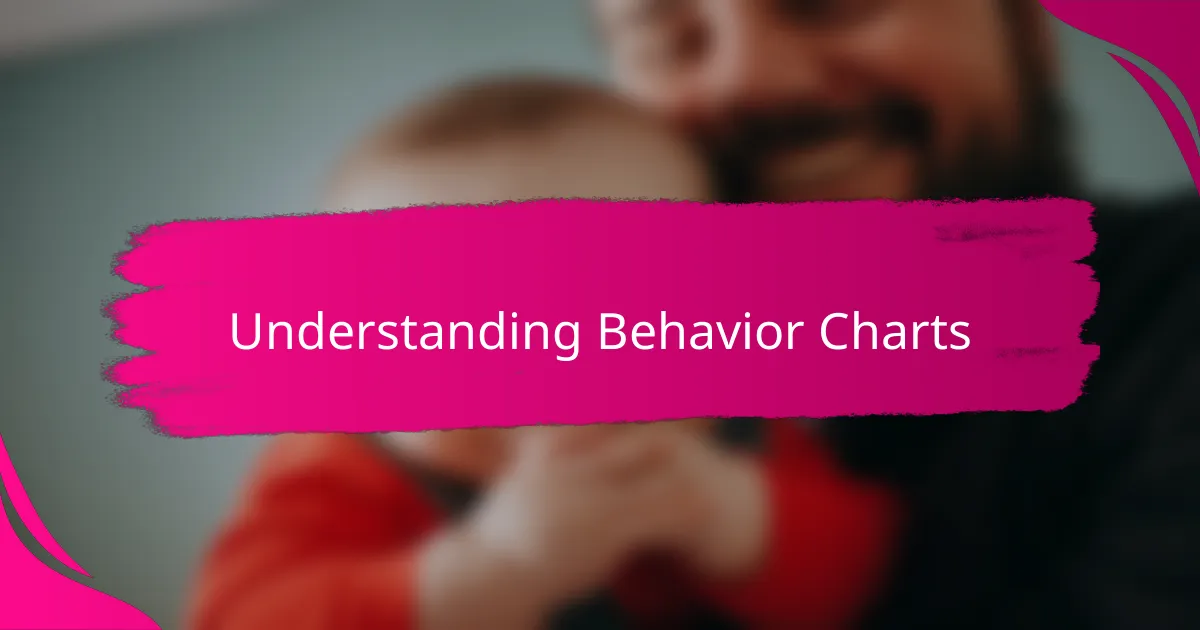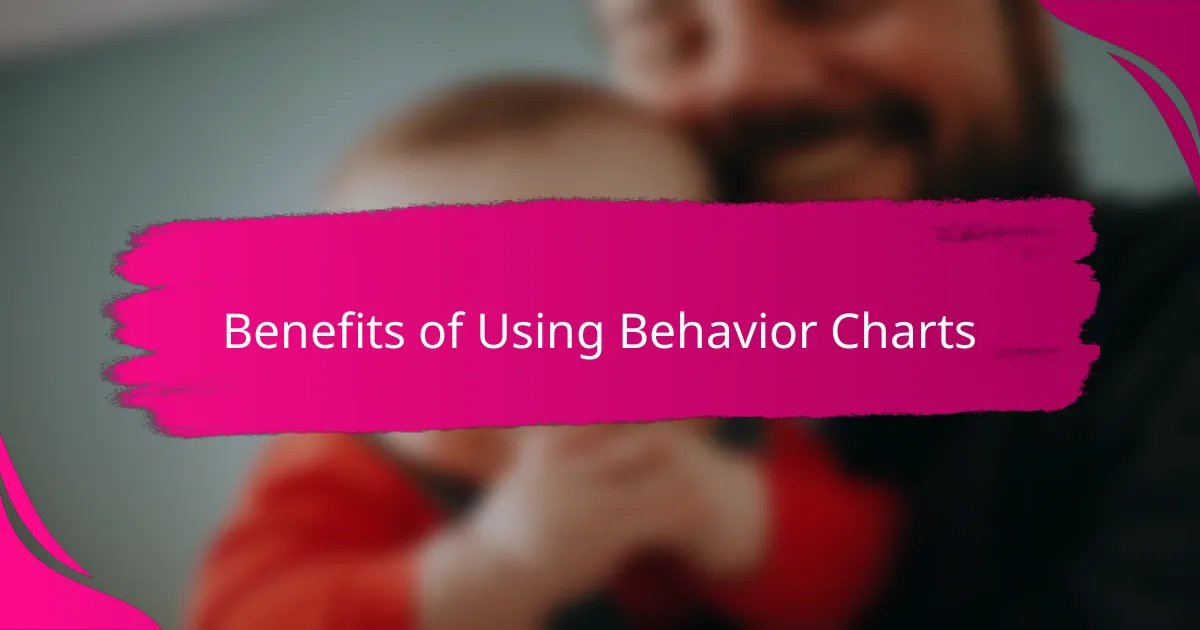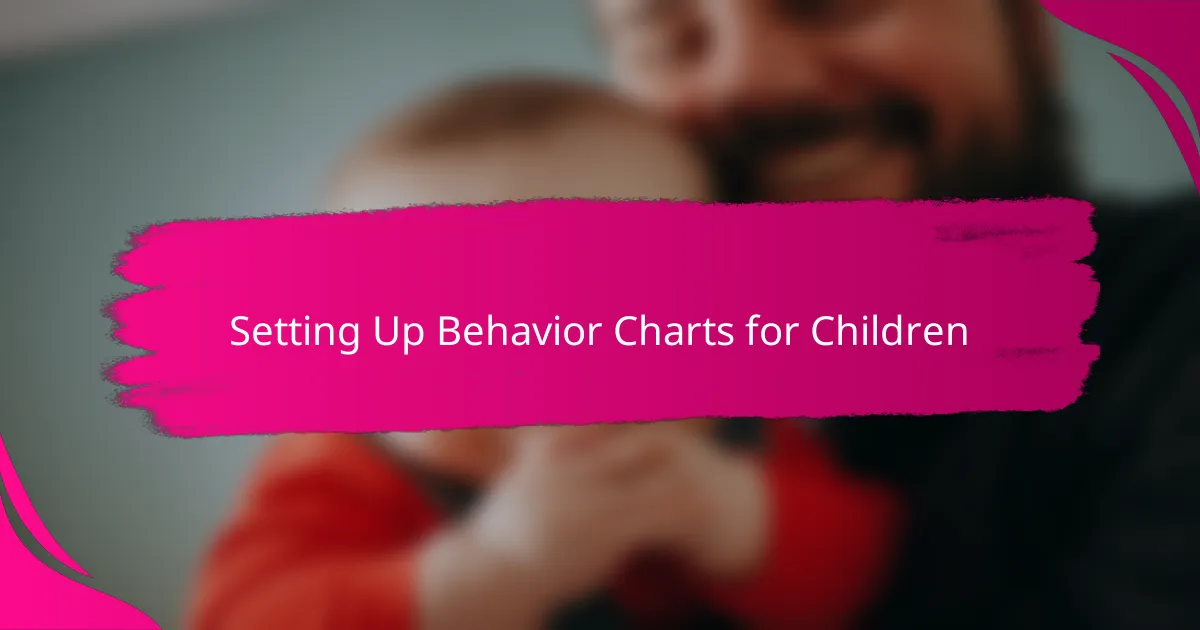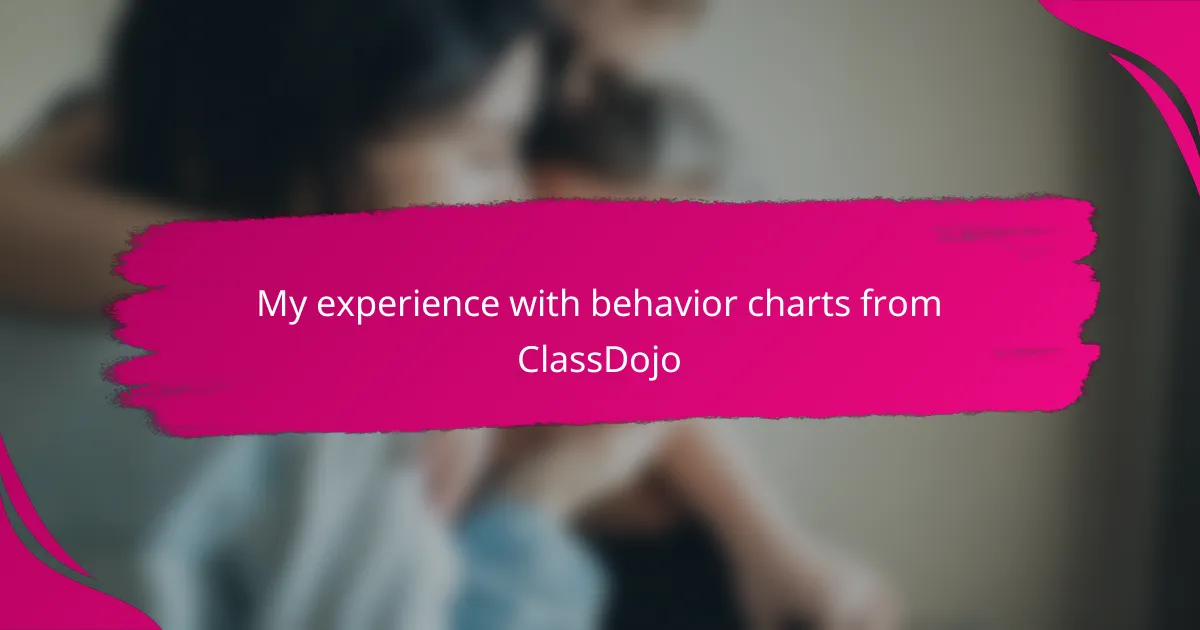Key takeaways
- Behavior charts provide a visual tool for tracking children’s behaviors, offering immediate feedback and promoting self-awareness.
- ClassDojo enhances communication between parents and teachers, fostering discussions that encapsulate specific behaviors rather than vague assessments.
- Effective behavior tracking requires simplicity, consistency, and an emphasis on understanding the reasons behind a child’s actions to encourage growth rather than just focus on rewards.
- A supportive approach to behavior charts can deepen family connections and create meaningful conversations about daily experiences.

Understanding Behavior Charts
When I first encountered behavior charts on ClassDojo, I wondered how a simple system could truly capture the complexity of a child’s daily actions. Behavior charts are essentially visual tools that track specific behaviors—positive or negative—helping both kids and parents see patterns over time. It made me think: can a color-coded system really motivate lasting change, or does it risk oversimplifying how children learn responsibility?
From my experience, the real power of a behavior chart lies in its clarity and consistency. Seeing a child’s progress in real-time provides immediate feedback, which can spark pride or prompt discussions without delay. Have you noticed how kids respond better when they see concrete evidence of their efforts rather than vague praise? That’s the kind of impact these charts aim for.
Yet, understanding behavior charts means recognizing their limits, too. They don’t tell the whole story behind a behavior—stress, tiredness, or outside influences might not show up on the screen but deeply affect a child’s conduct. Reflecting on this helped me stay patient and avoid jumping to quick conclusions, reminding me that charts are just one piece of a bigger parenting puzzle.

Introduction to ClassDojo Platform
ClassDojo is a classroom communication app that caught my attention because of its simple, user-friendly design. It connects teachers, parents, and students in real time, making it easier to stay updated on a child’s daily activities and progress. I remember thinking how refreshing it was to have a window into the classroom without feeling intrusive.
One thing that stood out to me about ClassDojo is its focus on positive reinforcement through a points system. Teachers can award points for good behavior, teamwork, or effort, which parents can see instantly. This immediate feedback loop felt like a game-changer compared to the usual once-a-week updates I was used to.
But I also wondered, does an app really create stronger home-school relationships? From what I experienced, it definitely opened more opportunities for conversations with my child about their day, making parenting a little less of a guessing game. Have you ever wished for that kind of insight? ClassDojo tries to offer exactly that.

Benefits of Using Behavior Charts
One of the biggest benefits I noticed with behavior charts is how they turn abstract ideas, like “being responsible” or “showing kindness,” into something tangible. When my child saw a visible record of their actions, it became easier for them—and for me—to celebrate small wins. Isn’t it amazing how instant feedback can boost a child’s confidence and encourage them to keep trying?
Another advantage I found is how behavior charts foster a shared language between parents, teachers, and kids. Instead of vague complaints or praises, we had a clear reference point to discuss what happened during the day. This helped me avoid misunderstandings and made our conversations more focused and productive, which feels like a relief in the chaos of daily parenting.
Lastly, from my perspective, behavior charts promote consistency. Kids thrive on routine and knowing what’s expected, and the chart acts like a steady guide through ups and downs. I remember a week when my child struggled with frustration, and the chart helped us track progress without losing sight of the bigger picture. Have you experienced moments when a simple tool like this keeps motivation on track? That’s the type of structure I believe behavior charts can provide.

Setting Up Behavior Charts for Children
Setting up behavior charts for children felt intimidating at first—I wasn’t sure how to pick the right behaviors to track without overwhelming my child. What worked for me was choosing just a few clear, achievable goals that mattered most, like sharing toys or following instructions. Have you ever tried narrowing down expectations to avoid confusion? Focusing on key behaviors made the chart feel like a helpful tool rather than a burden.
I also found it crucial to introduce the chart with enthusiasm and explain its purpose in a way my child could understand. Saying something like, “This chart is our way to celebrate the great choices you make every day,” seemed to spark genuine interest. It reminded me how important it is to frame tools like this positively—children respond well when they see these charts as games rather than punishments.
Timing and routine played a big role in making the chart part of our day. We made a habit of reviewing it together after school, turning it into a moment for connection rather than just accountability. Did you ever notice how a predictable moment can ease what might otherwise feel like pressure? For us, that daily check-in transformed the chart from a chore into a shared experience.

Personal Experience with ClassDojo Charts
Using ClassDojo’s behavior charts gave me a firsthand look at how technology can make parenting a bit more manageable. I remember one afternoon when my child proudly showed me their points for helping clean up without being asked—I felt a real sense of connection knowing we were tracking progress together. Have you ever felt like small moments like these get lost in the busyness of the day? That’s exactly what these charts helped me capture.
At times, I noticed the charts could be a double-edged sword. When my child had an off day, seeing fewer points sometimes led to frustration or disappointment, which made me realize that charts aren’t just about data—they tap deeply into a child’s emotions. How do you balance encouragement without making kids feel defined by numbers? For me, it took patience and gentle conversations to keep the focus on growth rather than perfection.
What stood out the most was how ClassDojo charts sparked honest conversations at home. Instead of vague “How was school?” questions, I could ask about specific behaviors and moments, which made discussions richer and more meaningful. Don’t you find that having concrete examples makes all the difference in understanding your child’s world? This simple tool became a bridge in our daily communication, and I can’t overstate how valuable that felt.

Challenges Faced and Solutions
At first, I struggled with how to interpret the points when my child’s behavior dipped—it was hard not to let those lower scores feel like failures. I had to remind myself that behavior charts like ClassDojo are snapshots, not the full story, and sometimes a tough day just means a need for extra support, not punishment. Have you ever felt that tension between wanting to track progress and not wanting your child to feel discouraged? It’s a delicate balance, but talking openly about what the points mean helped us both stay positive.
Another challenge was ensuring consistency between home and school. Sometimes, I noticed behaviors highlighted in the chart didn’t align perfectly with what I observed at home, which initially confused me. To solve this, I reached out to the teachers for clarification, turning the app into a true communication bridge rather than just a scoreboard. Could it be that these differences actually opened up opportunities for better understanding? For us, they did—because they prompted honest conversations that might not have happened otherwise.
Finally, I found that my child could become overly focused on earning points, which risked turning the system into a game rather than a tool for growth. To counter this, I emphasized the importance of effort and learning from mistakes rather than just chasing rewards. Have you noticed how shifting the focus from outcome to process can change a child’s attitude? In my experience, that mindset shift made the charts more empowering and less stressful for both of us.
![]()
Tips for Effective Behavior Tracking
One tip I’ve found invaluable is keeping the behavior goals simple and focused. When I tried tracking too many behaviors at once, both my child and I felt overwhelmed, and it lost its effectiveness. Have you ever noticed how narrowing down expectations helps keep everyone on the same page? Fewer, clearer targets made it easier to celebrate real progress without confusion.
Consistency is another must-have. I made it a habit to review the behavior chart at the same time every day—usually right after school. Those moments became a calm way to connect and reflect, rather than just a checklist. Doesn’t routine help create a sense of security for kids? For us, it turned the charts into positive rituals that motivated without pressure.
Lastly, I learned that attaching meaning to the points, not just counting them, really matters. Instead of focusing on the numbers alone, I asked questions like, “What made you choose kindness today?” This shifted the conversation from “Did you get the points?” to understanding the why behind actions. Have you tried digging into the story behind the scores? It deepened our dialogue and helped my child feel valued beyond the chart itself.
